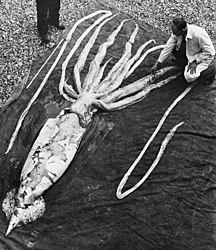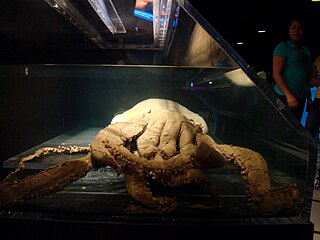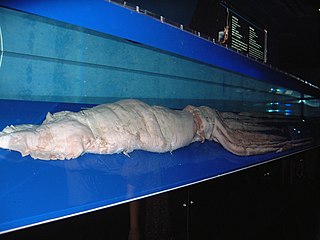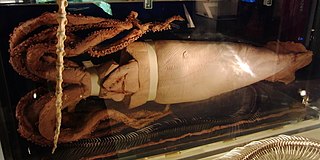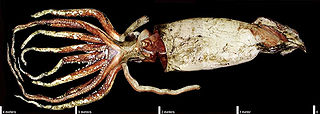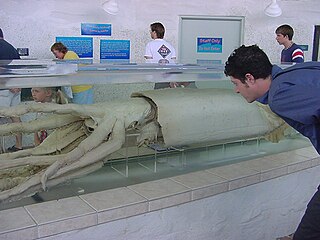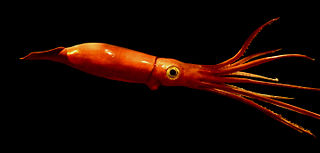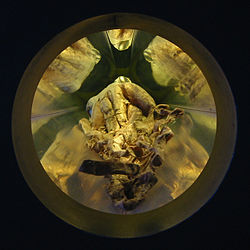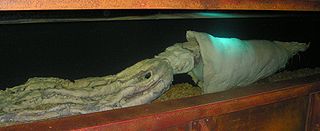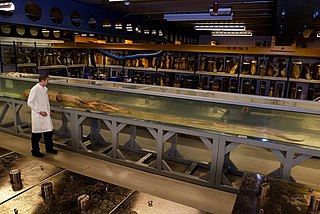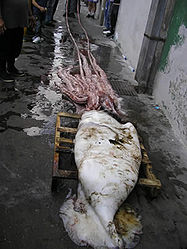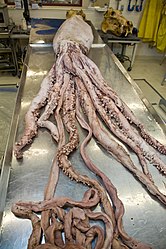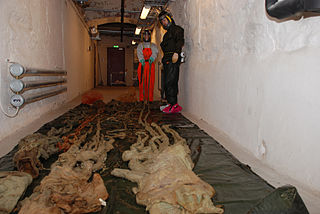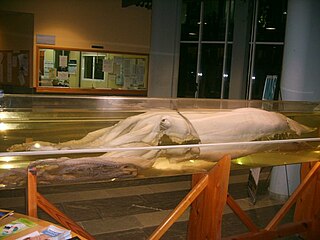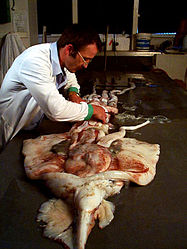User:Onetwothreeip/List of giant squid specimens and sightings

This list of giant squid specimens and sightings is a comprehensive timeline of recorded human encounters with members of the genus Architeuthis, popularly known as giant squid. It includes animals that were caught by fishermen, found washed ashore, recovered (in whole or in part) from sperm whales and other predatory species, as well as those reliably sighted at sea. The list also covers specimens incorrectly assigned to the genus Architeuthis in original descriptions or later publications.
Tales of giant squid have been common among mariners since ancient times, but the animals were long considered mythical, and often associated with the kraken of Nordic legend (Rees, 1949; Salvador & Tomotani, 2014; Hogenboom, 2014). Scientific acceptance did not materialise until specimens became available to zoologists in the second half of the 19th century, beginning with the formal naming of Architeuthis dux by Japetus Steenstrup in 1857, from fragmentary Bahamian material collected two years earlier (#14 on this list; Steenstrup, 1857:183; validated in Harting, 1860:11).[nb 2] The giant squid came to public prominence in 1861 when the French corvette Alecton encountered a live animal (#18) at the surface while navigating near Tenerife. A report of the incident filed by the ship's captain (Bouyer, 1861) was almost certainly seen by Jules Verne and adapted by him for the description of the monstrous squid in Twenty Thousand Leagues Under the Sea (Ellis, 1998a:79).
The giant squid's existence was established beyond doubt only in the 1870s, with the appearance of an extraordinary number of complete specimens—both dead and alive—in Newfoundland waters (beginning with #21; Earle, 1977; McConvey, 2015). These were meticulously documented in a series of papers by Yale zoologist Addison Emery Verrill (Coe, 1929:36; G.E. Verrill, 1958:69).[nb 3] The earliest known photographs of the giant squid were of two of these Newfoundland specimens, both from 1873: first a single severed tentacle—hacked off a live animal as it "attacked" a fishing boat (#28; Murray, 1874b:121)—and weeks later an intact animal in two parts (#29);[nb 4] the head and limbs of this latter specimen were famously shown draped over the sponge bath of Moses Harvey, a local clergyman, essayist, and amateur naturalist (Aldrich, 1987:109; Frank, 2014). Harvey secured and reported widely on both of these important specimens—as well as numerous others—and it was largely through his efforts that giant squid became known to North American and British zoologists (Aldrich, 1987:115). Recognition of Architeuthis as a real animal led to the reappraisal of earlier reports of gigantic tentacled sea creatures, with some of these subsequently being accepted as records of giant squid, the earliest stretching back to at least the 17th century (Ellis, 1994a:379, 1998a:257; Sweeney & Roper, 2001:[27]).
For a time in the late 19th century almost every major specimen of which material was saved was described as a new species. In all, some twenty species names were coined (Sweeney & Young, 2003). However, there is no widely agreed basis for distinguishing between the named species, and both morphological and genetic data point to the existence of a single, globally distributed species, which according to the principle of priority must be known by the earliest available name: Architeuthis dux (Aldrich, 1991:474; Förch, 1998:93; Winkelmann et al., 2013; Guerra et al., 2013).
It is not known why giant squid become stranded on shore, but it may be because the distribution of deep, cold water where they live is temporarily altered. Marine biologist and Architeuthis specialist Frederick Aldrich proposed that there may be a periodicity to the strandings around Newfoundland, and based on historical data suggested an average interval between mass strandings of some 30 years. Aldrich used this value to correctly predict a relatively small stranding event between 1964 and 1966 (beginning with #170; Aldrich, 1967a, 1968). Although strandings continue to occur sporadically throughout the world, few have been as frequent as those in Newfoundland in the late 19th century. A notable exception was a 15-month period between 2014 and 2015, during which an unprecedented 57 specimens were recorded from Japanese coastal waters of the Sea of Japan (beginning with #518; Kubodera et al., 2016; see also Sakamoto, 2014).[nb 5]
Though the total number of recorded giant squid specimens now runs into the hundreds, the species remains notoriously elusive and little known. By the turn of the 21st century, the giant squid remained one of the few truly large extant megafauna to have never been photographed alive, either in the wild or in captivity. Marine writer and artist Richard Ellis described it as "the most elusive image in natural history" (Ellis, 1998a:211). Early attempts to capture a glimpse of the animal in its natural habitat included a submersible expedition by Frederick Aldrich in the late 1980s (Ellis, 1998a:3).[nb 6] A photograph purporting to show a live Architeuthis dux alongside a diver was published by Poppe & Goto (1993), but this turned out to be a sick or dying Onykia robusta (misidentification #[7]; Ellis, 1998a:211; Norman, 2000:174). A number of expeditions were mounted in the 1990s with the aim of capturing footage of a live giant squid in its natural habitat (Pope, 1994; Fisher, 1995; Judd, 1996; [Anonymous], 1996c), but all were unsuccessful. They included Smithsonian-backed expeditions to the Azores in July 1996 and to Kaikoura Canyon off New Zealand in January–March 1997 and February–March 1999 (the former covered by National Geographic; Allen, 1997; McCarey & Rubin, 1998). These expeditions—the latter two each costing around $10 million—employed a combination of sperm whale-mounted crittercams, baited "ropecams" or "drop-cams", an Odyssey IIB autonomous underwater vehicle, and the single-person submersible Deep Rover (Fisher, 1997; Ellis, 1997a; Grzelewski, 2002). All three were led by giant squid expert Clyde Roper, with the first two also involving marine biologist Malcolm Clarke (Gomes-Pereira et al., 2017:823) and the last two Steve O'Shea of NIWA (Roper et al., 1997, 1999; Roper, 1998a, 1998b, 2000, 2006, 2013). A couple of years later, in 2001, O'Shea succeeded in capturing the first footage of a live giant squid when he caught and filmed several paralarval individuals in captivity (Baird, 2002). This milestone was followed by the first images of a live adult giant squid (at the surface) on 15 January 2002, in Kyoto Prefecture, Japan (#442; [Anonymous], 2002b; O'Shea, 2003f).[nb 7] These were joined by a number of little-publicised photographs of live adults at the surface off Okinawa (#449, 450, and 464).[nb 8] Another unsuccessful attempt to film a live giant squid in the wild was made off the Spanish coast of Asturias in September 2002, led by Ángel Guerra (Barreiro, 2002; Sitges, 2003; Soriano, 2003; Guerra, 2013). It was only on 30 September 2004 that a live giant squid was photographed in its natural deep-water habitat, off the Ogasawara Islands, by Tsunemi Kubodera and Kyoichi Mori (#466; Kubodera & Mori, 2005; Kubodera, 2010:25). Kubodera and his team, again working off the Ogasawara Islands, subsequently became the first to film a live adult giant squid on 4 December 2006 (#473; [Reuters], 2007; Kubodera, 2010:38). However, the quest to film a live giant squid in its natural habitat continued, with an unsuccessful National Geographic-backed attempt off the Azores in 2011, headed by camera expert Martin Dohrn and assisted by Clarke ([Anonymous], 2011a; Gomes-Pereira et al., 2017:824). The following year a team including Natacha Aguilar de Soto of the University of La Laguna lowered a camera to a depth of 200–800 m off El Hierro, Canary Islands, but to no avail (Ardoy, 2013). The elusive footage was finally captured by a team comprising Kubodera, O'Shea and Edith Widder in July 2012 (#507; [NHK], 2013a, b; Widder, 2013a, b). Since then, live giant squid have been photographed and filmed at the surface on a number of occasions, mostly in Japanese waters (#519, 524, 556, 561, 565, and 581), but also off Spain (#583) and South Africa (#584).[nb 9]
Despite these recent advances and the growing number of both specimens and recordings of live animals, the giant squid continues to occupy a unique place in the public imagination (Guerra et al., 2011:1990). As Roper et al. (2015:83) wrote: "Few events in the natural world stimulate more excitement and curiosity among scientists and laymen alike than the discovery of a specimen of Architeuthis."
Overview
[edit]Sourcing and progenitors
[edit]
The present list generally follows "Records of Architeuthis Specimens from Published Reports", compiled by zoologist Michael J. Sweeney of the Smithsonian Institution and including records through 1999 (Sweeney & Roper, 2001), with additional information taken from other sources (see Full citations). While Sweeney's list is sourced almost entirely from the scientific literature, many of the more recent specimens are supported by reports from the news media, including newspapers and magazines, radio and television broadcasts, and online sources.
Earlier efforts to compile a list of all known giant squid encounters throughout history include those of marine writer and artist Richard Ellis (Ellis, 1994a:379–384, 1998a:257–265), and these too have informed the present list. Records which appear in Ellis's 1998 list but are not found in Sweeney & Roper's 2001 list have a citation to Ellis (1998a)—in the page range 257–265—in the 'Additional references' column of the main table.
In addition to these global specimen lists, a number of regional compilations have been published, including Aldrich (1991) for Newfoundland, Okiyama (1993) for the Sea of Japan, Förch (1998:105–110) for New Zealand, Guerra et al. (2006:258–259) for Asturias, Spain, and Roper et al. (2015) for the western North Atlantic. Works exhaustively enumerating all recorded specimens from a particular mass appearance event include those of Verrill (1882c) for Newfoundland in 1870–1881 and Kubodera et al. (2016) for the Sea of Japan in 2014–2015. Though the number of authenticated giant squid records now runs into the hundreds, individual specimens still generate considerable scientific interest and continue to have scholarly papers unto themselves (e.g. Leite et al., 2016; Funaki, 2017; Romanov et al., 2017; Shimada et al., 2017; Guerra et al., 2018).
Scope and inclusion criteria
[edit]The list includes records of giant squid (genus Architeuthis) either supported by a physical specimen (or parts thereof) or—in the absence of any saved material—where at least one of the following conditions is satisfied: the specimen was examined by an expert prior to disposal and thereby positively identified as a giant squid; a photograph or video recording of the specimen was taken, on the basis of which it was assigned to the genus Architeuthis by a recognised authority; or the record was accepted as being that of a giant squid by a contemporary expert or later authority (whether due to the perceived credibility of the source, the verisimilitude of the account, or for any other reason).

Purported sightings of giant squid lacking both physical and documentary evidence and expert appraisal (the most dubious tending towards "big fish stories") are generally excluded, with the exception of those appearing in the lists of Ellis (1994a:379–384), Ellis (1998a:257–265), or Sweeney & Roper (2001).[nb 10]The earliest records of very large squid date to classical antiquity, and the writings of Aristotle and Pliny the Elder (Gerhardt, 1966:171; Muntz, 1995; Ellis, 1998a:11). But in the absence of detailed descriptions or surviving remains, it is not possible to assign these to the giant squid genus Architeuthis with any confidence, and they are therefore not included in this list. Basque and Portuguese cod fishermen observed what were likely giant squid carcasses in the waters of the Grand Banks of Newfoundland as early as the 16th century (Roper et al., 2015:78), but conclusive evidence is similarly lacking. The earliest specimens identifiable as true giant squid are generally accepted to be ones from the early modern period in the 17th and 18th centuries (Ellis, 1994a:379), and possibly as far back as the 16th century (Ellis, 1998a:257; Sweeney & Roper, 2001:[27]; Guerra et al., 2004a:428; though see Paxton & Holland, 2005).
All developmental stages from hatchling to mature adult are included. In the literature there is a single anecdotal account of a giant squid "egg case" (Gudger, 1953:199; Lane, 1957:129; Ellis, 1994a:144), but this is excluded due to a lack of substantiating evidence. Indirect evidence of giant squid (such as sucker scars found on sperm whales) falls outside the scope of this list.
Specimens misassigned to the genus Architeuthis in print publications or news reports are also included, but are clearly highlighted as misidentifications.
Number and origin of specimens
[edit]
The genus Architeuthis has a cosmopolitan (Okutani, 2015) or bi-subtropical distribution (Nesis, 2003). The greatest numbers of specimens have been recorded in the North Atlantic around Newfoundland (historically) and the Iberian Peninsula (more recently; Laria, N.d.), in the South Atlantic off South Africa and Namibia, in the northwestern Pacific off Japan (especially more recently; Kubodera et al., 2016), and in the southwestern Pacific around New Zealand and Australia (Roper & Shea, 2013:111). The vast majority of specimens are of oceanic origin, including marginal seas broadly open to adjacent ocean, especially the Tasman Sea and Sea of Japan, but also the Gulf of Mexico and Caribbean Sea (Roper et al., 2015), among others. A handful are known from the far western Mediterranean Sea (#380, 427, 469, and 508), but these records do not necessarily indicate that the Mediterranean falls within the natural range of the giant squid, as the specimens may have been transported there by inflowing Atlantic water (Roper & Shea, 2013:111). Similarly, giant squid are unlikely to naturally occur in the North Sea owing to its shallow depth (Roper & Shea, 2013:111; though see e.g. #108). They are generally absent from equatorial and high polar latitudes (Roper & Jereb, 2010:121).
According to Guerra et al. (2006), 592 confirmed giant squid specimens were known as of the end of 2004. Of these, 306 came from the Atlantic Ocean, 264 from the Pacific Ocean, 20 from the Indian Ocean, and 2 from the Mediterranean Sea. The figures for specimens collected in the Atlantic and Pacific Oceans further broke down as follows: 126 in the northwestern Atlantic, 148 in the northeastern Atlantic, 6 in the southwestern Atlantic, 26 in the southeastern Atlantic, 28 in the northwestern Pacific, 43 in the northeastern Pacific, 183 in the southwestern Pacific, and 10 in the southeastern Pacific (Guerra et al., 2006).

Guerra & González (2009) reported that the total number of recorded giant squid specimens stood at 624. Guerra et al. (2011) gave an updated figure of 677 specimens (see table below). Paxton (2016a) put the total at around 700 as of 2015, of which c. 460 had been measured in some way. This number has increased substantially in recent years, with 57 specimens recorded from the Sea of Japan over an extraordinary 15-month period in 2014–2015 (beginning with #518; Kubodera et al., 2016). The giant squid nevertheless remains a rarely encountered animal, especially considering its large size, with Ellis (1994a:133) writing that "each giant squid that washes up or is taken from the stomach of a sperm whale is still an occasion for a teuthological celebration".
Preserved giant squid specimens are much sought after for display (Landman & Ellis, 1998; Ablett, 2012). Guerra et al. (2011:1990) estimated that around 30 were exhibited at museums and aquaria worldwide, while Guerra & Segonzac (2014:118–119) provided an updated list of 35 (21 in national museums and 14 in private institutions). The purpose-built Centro del Calamar Gigante in Luarca, Spain, had by far the largest collection on public display (4 females and 1 male; Guerra & Segonzac, 2014:118), but many of the museum's 14 or so specimens were destroyed during a storm on 2 February 2014 ([Anonymous], 2014c, d). At least 13 specimens were exhibited in Japan as of February 2017, of which 10 had been acquired since 2013 (Shimada et al., 2017:9).
| Region | Number of specimens | % of total | Found stranded or floating (%) | From fishing (%) | From predators (%) | Method of capture unknown (%) |
|---|---|---|---|---|---|---|
| NW Atlantic | 148 | 21.9 | 61 | 30 | 1 | 8 |
| NE Atlantic | 152 | 22.5 | 49 | 31 | 15 | 5 |
| SW Atlantic | 6 | 0.9 | 50 | 16 | 1 | 33 |
| SE Atlantic | 60* | 8.9 | 10 | 60 | 17 | 13 |
| NW Pacific | 30* | 4.4 | 30 | 35 | 30 | 5 |
| NE Pacific | 43 | 6.4 | 7 | 56 | 30 | 7 |
| SW Pacific | 183 | 27.0 | 12 | 41 | 42 | 5 |
| SE Pacific | 10 | 1.5 | 90 | 10 | 0 | 0 |
| Indian Ocean | 33** | 4.8 | 6 | 94 | 0 | 0 |
| W Mediterranean | 3 | 0.4 | 100 | 0 | 0 | 0 |
| Equatorial/tropical | 9 | 1.3 | 11 | 44 | 45 | 0 |
| All regions | 677 | 100.0 |
- * Underestimates according to Guerra et al. (2011).
- ** Includes records from Durban, South Africa.
Caveats
[edit]Reported sizes
[edit]
Giant squid size—long a subject of both popular debate and academic inquiry (Ellis, 1998b; Paxton, 2016a, b; Bittel, 2016; Romanov et al., 2017)—has often been misreported and exaggerated. Reports of specimens reaching or even exceeding 18 m (59 ft) in total length are widespread, but no animals approaching this size have been scientifically documented in recent times, despite the hundreds of specimens available for study. The 55 ft (16.76 m) "Thimble Tickle specimen" (#46) reported by Verrill (1880a:191) is often cited as the largest giant squid ever recorded, and the 55 ft 2 in (16.81 m) specimen described by Kirk (1888) as Architeuthis longimanus (#62)—a strangely proportioned animal that has been much commented on[nb 11]—is sometimes cited as the longest (O'Shea & Bolstad, 2008; Paxton, 2016a). It is now thought likely that such lengths were achieved by great lengthening of the two long feeding tentacles, analogous to stretching elastic bands, or resulted from inadequate measurement methods such as pacing (O'Shea & Bolstad, 2008; Dery, 2013; Roper & Shea, 2013:113; Hanlon & Messenger, 2018:267).
Based on a 40-year data set of more than 50 giant squid (Architeuthis dux) specimens, Roper & Shea (2013:114) suggest an average total length at maturity of 11 m (36 ft) and a "rarely encountered maximum length" of 14–15 m (46–49 ft). Of the nearly 100 specimens examined by Clyde Roper, the largest was "46 feet (14 m) long" (Cerullo & Roper, 2012:22). O'Shea & Bolstad (2008) give a maximum total length of 13 m (43 ft) for females based on the examination of more than 130 specimens, measured post mortem and relaxed, as well as beaks recovered from sperm whales (which do not exceed the size of those found in the largest complete specimens). Steve O'Shea estimated the maximum total length for males at 10 m (33 ft) (O'Shea, 2003c). Charles G. M. Paxton performed a statistical analysis using literature records of giant squid specimens and concluded that "squid with a conservative TL of 20 m [66 ft] would seem likely based on current data" (Paxton, 2016a, b), but the study has been heavily criticised by experts in the field (Greshko, 2016).

O'Shea & Bolstad (2008) give a maximum mantle length of 225 cm (7.38 ft) based on the examination of more than 130 specimens, as well as beaks recovered from sperm whales (which do not exceed the size of those found in the largest complete specimens), though there are recent scientific records of specimens that slightly exceed this size (such as #362, a 240 cm (7.9 ft) ML female captured off Tasmania, Australia, reported by Landman et al., 2004:686 and cited by Roper & Shea, 2013:114). Questionable records of up to 500 cm (16 ft) ML can be found in older literature (Roper & Jereb, 2010:121). Paxton (2016a) accepts a maximum recorded ML of 279 cm (9.15 ft), based on the Lyall Bay specimen (#48) reported by Kirk (1880:312), but this record has been called into question as the gladius of this specimen was said to be only 190 cm (6.2 ft) long (Greshko, 2016).
Including the head and arms but excluding the tentacles (standard length, SL), the species very rarely exceeds 5 m (16 ft) according to O'Shea & Bolstad (2008). Paxton (2016a) considers 9.45 m (31.0 ft) to be the greatest reliably measured SL, based on a specimen (#47) reported by Verrill (1880a:192), and considers specimens of 10 m (33 ft) SL or more to be "very probable", but these conclusions have been criticised by giant squid experts (Greshko, 2016).
O'Shea (2003c) put the maximum weight of female giant squid at 275 kg (606 lb), based on the examination of some 105 specimens as well as beaks recovered from sperm whales (which do not exceed the size of those found in the largest complete specimens; some of the heaviest recent specimens include #465 and 486). Giant squid are sexually size dimorphic, with the maximum weight for males estimated at 150 kg (330 lb) (O'Shea, 2003c), though heavier specimens have occasionally been reported (see #401 for 190 kg (420 lb) specimen). Roper & Jereb (2010:121) give a maximum weight of up to 500 kg (1,100 lb), and "possibly greater". Discredited weights of as much as a tonne (2,200 lb) or more are not uncommon in older literature (see e.g. #22, 115, and 118; O'Shea & Bolstad, 2008).
Species identifications
[edit]The taxonomy of the giant squid genus Architeuthis has not been entirely resolved. Lumpers and splitters may propose as many as eight species or as few as one, with most authors recognising either one cosmopolitan species (A. dux) or three geographically disparate species: A. dux from the Atlantic, A. martensi from the North Pacific, and A. sanctipauli from the Southern Ocean (Ellis, 1998a:73; Norman, 2000:150; Roper & Jereb, 2010:121). Historically, some twenty species names (not counting new combinations) and eight genus names have been applied to architeuthids (see Type specimens; Sweeney & Young, 2003). No genetic or physical basis for distinguishing between the named species has been proposed (Glaubrecht & Salcedo-Vargas, 2004:62), though specimens from the North Pacific do not appear to reach the maximum dimensions seen in giant squid from other areas (Roper & Jereb, 2010:123). There may also be regional differences in the relative proportions of the tentacles and their sucker counts (see Roeleveld, 2002). The mitogenomic analysis of Winkelmann et al. (2013) supports the existence of a single, globally distributed species (A. dux; [UCPH], 2013). The same conclusion was reached by Förch (1998) on the basis of morphological data.
The literature on giant squid has been further muddied by the frequent misattribution of various squid specimens to the genus Architeuthis, often based solely on their large size. In the academic literature alone, such misidentifications encompass at least the oegopsid families Chiroteuthidae (misidentification #[8]—Asperoteuthis lui), Cranchiidae (#[5] and [6]—Mesonychoteuthis hamiltoni), Ommastrephidae (#[1]—Sthenoteuthis pteropus and #[2]—Dosidicus gigas), Onychoteuthidae (#[7] and [10]—Onykia robusta), and Psychroteuthidae (#[4]—indeterminate species) (see Ellis, 1998a; Salcedo-Vargas, 1999; Glaubrecht & Salcedo-Vargas, 2004). Many more misidentifications have been propagated in the popular press, involving—among others—Megalocranchia cf. fisheri (#[11]; Cranchiidae) and Thysanoteuthis rhombus (#[9]; Thysanoteuthidae). This situation is further confused by the occasional usage of the common name 'giant squid' in reference to large squids of other genera (Robson, 1933:681).
Specimen images
[edit]The number below each image corresponds to the specimen or sighting in the List of giant squid that the image depicts. The date on which the specimen was first captured, found, or observed is also given (the little-endian day/month/year date format is used throughout).
-
#1 (c. 1546)
Japetus Steenstrup's comparison of a squid (centre; its tentacles in an anatomically implausible position) with two 16th century drawings of the "sea monk of the Øresund" (Rondelet's on the left, Belon's on the right), most probably found in 1546 or slightly earlier -
#3 (~15/10/1673)
Broadsheet covering the giant squid stranded at Dingle, Ireland, around 15 October 1673. Steve O'Shea commented that though the animal depicted "doesn't look true to any squid, it is probably more similar to a cranchiid than it is to an architeuthid" (O'Shea, 2003e). -
#18 (30/11/1861)
An 1865 illustration of the Alecton incident, obviously based on the officers' watercolour -
#28 (26/10/1873)
Victor Nehlig's 1881 impression of fisherman Theophilus Picot's encounter with a giant squid off Portugal Cove, Newfoundland, on 26 October 1873. -
#28 (26/10/1873)
The 19-foot (5.8 m) tentacle of the first Architeuthis ever examined on land, hacked off a living animal on 26 October 1873 -
#29 (25/11?/1873)
The mutilated mantle of the specimen from Logy Bay, Newfoundland, photographed in Moses Harvey's home (the caudal fin is visible on the right) -
#29 (25/11?/1873)
The Logy Bay giant squid draped over Reverend Moses Harvey's sponge bath, November or December 1873 -
#29 (25/11?/1873)
Line drawings taken from two photographs of the Logy Bay specimen. Note that the upper illustration is based on a slightly different frame to the preceding one (as evidenced by the contrasting orientation of the beak and arrangement of arm tips on the lower left, which are closer to those seen in this version). -
#29 (25/11?/1873)
A.E. Verrill's reconstruction of "Architeuthis Harveyi", the Logy Bay giant squid -
#34 (?/12/1874)
Drawing by A.E. Verrill, from specimen obtained at Fortune Bay, Newfoundland, in December 1874 -
#43 (24/9/1877)
The "nearly perfect specimen" that was beached alive in Catalina, Trinity Bay, Newfoundland, on 24 September 1877, from the 27 October 1877 issue of Canadian Illustrated News -
#43 (24/9/1877)
Illustration of the "devil-fish" from Catalina, from the 3 November 1877 issue of Harper's Weekly ([Anonymous], 1877a:867) -
#43 (24/9/1877)
Another depiction of the Catalina specimen, from the cover of the 17 November 1877 issue of The Penny Illustrated Paper and Illustrated Times ([Anonymous], 1877b:305) -
#43 (24/9/1877)
Another depiction of the Catalina specimen, showing the animal after it had died -
#43 (24/9/1877)
J. H. Emerton's drawing of the Catalina giant squid -
?#45 (21/11/1877)
Giant squid beached on the Newfoundland coast, apparently on 22 November 1877 (closest is #45 from 21 November, from Smith's Sound). Note similarity to illustration of Catalina specimen (#43). -
#62 (?/10/1887)
T. W. Kirk's sketch of the Architeuthis longimanus type specimen in lateral aspect, from Kirk (1888). Note the extreme length of the feeding tentacles relative to the mantle and arms. -
#68 (18/7/1895)
Mantle measuring 46 cm originally recovered from sperm whale vomit, from a 1900 work by Louis Joubin. This specimen is the holotype of Dubioteuthis physeteris. -
#69 (10/4/1896) and #70 (27/9/1896)
The two largest Norwegian giant squid specimens, measuring 10 and 12 m in total length, were both found washed ashore at Kyrksæterøra in 1896. -
#69 (10/4/1896) or #70 (27/9/1896)
One of the two giant specimens from Kyrksæterøra, stretched out for measurement -
Giant squid that "came ashore on the Scottish west coast", date not specified (Bright, 1989:64–65).
-
#102 (4/3/1928)
Specimen found washed ashore in Ranheim, Norway, measuring around 7.9 m in total length -
#240 (?/2/1980)
Specimen that washed ashore on Plum Island, Massachusetts, in early February 1980, exhibited at the National Museum of Natural History in Washington, D.C. -
#240 (?/2/1980)
Since 2009, the Plum Island specimen has been on loan to the Georgia Aquarium in Atlanta, where it is on display in the Cold Water Quest Gallery -
#254 (10/11/1981)
Giant squid during dissection at the Memorial University of Newfoundland. This specimen was recovered in Bonavista North, Newfoundland. -
#342 (?/8/1994)
Specimen exhibited at Okinawa Churaumi Aquarium, Japan, measuring 6.37 m in total length including its intact tentacles -
#380 (?/?/1998)
First known specimen from the Mediterranean Sea, on display at the Museo Alborania in Málaga, Spain. Preserved in formaldehyde, it is an immature female with a mantle length of around 1.25 m. -
(20/2/1999)
Giant squid at the National Institute of Water and Atmospheric Research, Wellington, New Zealand -
#396 (15/3/1999)
Giant squid nicknamed "Molly the Mollusk", preserved in a tank at Mote Aquarium in Sarasota, Florida -
#414 (27/1/2000)
The world's first plastinated giant squid, displayed at the Muséum national d'histoire naturelle in Paris -
#441 (3/1/2002)
Giant squid caught around 160 km off the Hebrides, preserved at the National Marine Aquarium in Plymouth, England -
#455 (?/8/2003)
Giant squid specimen with tentacles fully extended, exhibited at the German Oceanographic Museum in Stralsund -
#463 (15/3/2004)
Specimen nicknamed "Archie" being imaged and measured in the Tank Room of the Natural History Museum in London -
#463 (15/3/2004)
"Archie" preserved in a 9.45 m-long acrylic tank at London's Natural History Museum -
(?/7/2005)
Male specimen caught in Spanish waters in July 2005 -
(?/7/2005)
Same specimen on display at the Sant Ocean Hall of the National Museum of Natural History in Washington, D.C. -
(?/7/2005)
Large female caught off northern Spain -
(?/7/2005)
Same specimen being prepared for display at the National Museum of Natural History -
(?/7/2005)
Same specimen on display at the NMNH's Sant Ocean Hall, preserved in 3M Novec fluid -
#512 (30/5/2013)
Dead specimen seen from an operating seismic vessel off Brazil -
Specimen on display at the Melbourne Museum
-
Several giant squid specimens from the NTNU Museum of Natural History and Archaeology in Trondheim, Norway. The oldest specimen (#70), found in 1896, is also the largest at 12 m in total length.
-
Giant squid display at Kelly Tarlton's Underwater World in Auckland, New Zealand
-
Giant squid head recovered from a sperm whale stomach, at the London Natural History Museum's Darwin Centre
-
Giant squid dissection performed by Clyde Roper (top left) and scientists from NOAA and the Delaware Museum of Natural History
-
Giant squid on display at the Faculty of Marine Sciences, University of Vigo
-
Specimen identified as Architeuthis sanctipauli, at the National Museum of Natural Science in Taichung, Taiwan
-
A small (1 m ML; 30 kg) but fully mature male being examined by Steve O'Shea on 28 February 1999, during the "In Search of Giant Squid" expedition
-
Dried giant squid originally measuring 3 m in length
Notes and references
[edit]Explanatory footnotes
[edit]- ^ Verrill's marginal annotations read as follows: "Architeuthis monachus (No. 5) Logie Bay, N. Foundland about 1⁄8 natural size between 1⁄8 and 1⁄9. The tub is 38 1⁄2 inches in diameter and circular. Harvey (?) letter. Some of the suckers are broken off on the short arms. They alternate in two regular rows. On the club of the long arm there is a marginal row of small suckers on each side alternating with the large ones. One sucker gone on this long arm." (Aldrich, 1991:459).
- ^ A small number of naturalists became convinced of the existence of giant cephalopods even prior to Steenstrup's writings, one example being Hamilton Smith, F.R.S., who examined a beak and other parts of an "enormous Sepia" preserved at the Museum of Haarlem, now known as Teylers Museum, and presented his findings to the British Association for the Advancement of Science in 1841 (Smith, 1842:73; Earle, 1977:20).
- ^ Ellis (1998a:86) described Verrill as someone with "an almost limitless capacity for work", who "began publishing papers on these specimens almost as fast as they came in". The full list of Verrill's publications on the Newfoundland strandings of 1870–1881 is as follows: Verrill 1874a, b, 1875a, b, c, 1876, 1877, 1878, 1880a, b, 1881a, b, 1882a, c.
- ^ The Logy Bay specimen of November 1873 (#29 on this list) was the first complete giant squid to be photographed (Offord, 2016; Keartes, 2016a), albeit in two parts and across two frames (Aldrich, 1991:458). Although cited by Aldrich (1991:459) as "the first photographs of an architeuthid in North America", the specimen directly preceding it chronologically (by almost exactly a month; #28 from Portugal Cove) was also photographed, though here only a severed tentacle—the only part saved—was imaged. Woodcuts prepared from this latter photograph appeared in a number of periodicals of the time, including The Field and The Annals and Magazine of Natural History (Harvey, 1874a:68; Verrill, 1875a:34). The giant squid found beached on Île Saint-Paul on 2 November 1874 (#33) was another early specimen to be photographed (Wright, 1878:329).
- ^ Unconfirmed mass appearances of giant squid include the claim by Frederick Aldrich that a "school of 60 has been sighted off the coast of Newfoundland" (Aldrich, 1967b), possibly in reference to #39. Richard Ellis noted that Aldrich never repeated this claim in print, "so it is likely that he learned it was not accurately reported" (Ellis, 1998a:241). Aldrich also told Clyde Roper that "Grand Banks fishermen have reported seeing hundreds of giant squid bodies floating on the surface" (Roper & Shea, 2013:111).
- ^ More than 20 years earlier, in the summer of 1965, Aldrich had enquired about using the recently commissioned manned deep-ocean research submersible DSV Alvin to study the life habits of the giant squid (including a photo of #170 with his letter), but the idea never progressed due to funding issues. The original proposal for Aluminaut, another manned submersible launched around the same time as Alvin, also mentioned the giant squid, but this project was never realised either (Oreskes, 2003:716; Oreskes, 2014:29).
- ^ Though see specimen #320 from Tottori Prefecture, Japan, which was reportedly still alive when found stranded in shallow water on 16 April 1988, where it was photographed in situ (Wada et al., 2014:67, fig. 1).
- ^ A number of photographs of live adult giant squid at the surface off Okinawa came to light in 2003 (#449 and 450; [Anonymous], c. 2003), but it is uncertain when these were taken (O'Shea, 2003g; Eyden, 2006). Another live animal was photographed at the surface in the same area on 15 April 2004 (#464; [Anonymous], 2004a).
- ^ An exhaustive list of giant squid that were photographed while still alive would include specimens such as #515, which was found beached and immobile but "still breathing" (Scheepers, 2017), and possibly many others. For the sake of brevity, however, only live animals that were photographed or filmed in water—where buoyancy makes their animateness more readily discernible—are listed here.
- ^ Published purported giant squid sightings thus excluded include those of J. D. Starkey from World War II (Starkey, 1963; Bright, 1989:148; Ellis, 1998a:204; Paxton, 2016a:83), Dennis Braun from 1969 (Ellis, 1998a:245; Paxton, 2016a:83), Jacques Cousteau (Cousteau & Diolé, 1973:205; Ellis, 1998a:208), Tim Lipington from 1994 (Lipington, 2007–2009; Lipington, 2008; Paxton, 2016a:83), C. A. McDowall (McDowall, 1998; Ellis, 1998a:248), Gordon Robertson (Revkin, 2013), and the "Giant Squid Found" MonsterQuest episode (see Cassell, 2007). Supposed specimens thus excluded include Charles H. Dudoward's 1892 and 1922 carcasses (variously described as octopuses or squid; LeBlond & Sibert, 1973:11,32; Bright, 1989:140; Ellis, 1998a:202) and the so-called St. Augustine Monster of 1896 (initially postulated by Verrill, 1897:79 to be a giant squid, later a gigantic octopus, and eventually shown to be the remains of a whale).
- ^ Cite error: The named reference
longimanuswas invoked but never defined (see the help page).





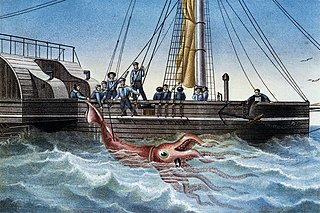










![#43 (24/9/1877) Illustration of the "devil-fish" from Catalina, from the 3 November 1877 issue of Harper's Weekly ([Anonymous], 1877a:867)](http://upload.wikimedia.org/wikipedia/commons/thumb/6/64/Giant_squid_from_Harper%27s_Weekly%2C_3_November_1877.jpg/320px-Giant_squid_from_Harper%27s_Weekly%2C_3_November_1877.jpg)
![#43 (24/9/1877) Another depiction of the Catalina specimen, from the cover of the 17 November 1877 issue of The Penny Illustrated Paper and Illustrated Times ([Anonymous], 1877b:305)](http://upload.wikimedia.org/wikipedia/commons/thumb/b/b4/The_great_Atlantic_devil-fish_aground_on_the_Newfoundland_coast.jpg/255px-The_great_Atlantic_devil-fish_aground_on_the_Newfoundland_coast.jpg)











